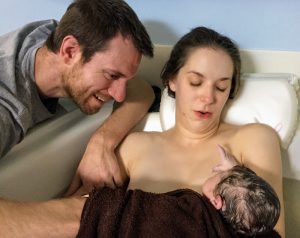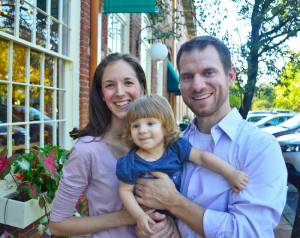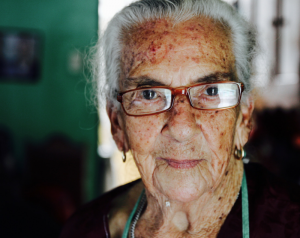By Bradley Bethel
If I could make one recommendation to every expectant dad, it would be this: accompany your partner to her prenatal appointments (with her permission, of course).
For many of us men, pregnancy seems like an unfathomable mystery. Obviously, if we’re about to be become dads, we know something about how a woman becomes pregnant — that’s the easy part. Beyond that, however, society does little to help us understand pregnancy itself or how to support our partners through the process. For generations, we’ve been socialized according to gender norms that minimize men’s role during pregnancy and keep us ignorant about it. No wonder we’re often bewildered by the whole experience.
Unlike the days of Call the Midwife, men are now welcome, even expected, to be with their partners during labor. Yet often our only preparation is a short series of weekly childbirth classes. Somehow, in six weeks, we’re supposed to undo a lifetime of exposure to sensationalized, frightening media depictions of childbirth and then feel prepared to assume the role of a calm, supporting partner.
When my spouse, Tracy, became pregnant two years ago, I was eager to become a dad. But like most expectant fathers, I was anxious about my role during childbirth. Would I be able to provide adequate support to Tracy while she labors? What if something were to go wrong? Would I know what decision to make? How could I possibly remain calm and supportive through something as seemingly terrifying as childbirth?
Fortunately, by the time Tracy woke me up on a Thursday morning several months later to tell me today is the day, my fears had subsided, and I felt ready to provide the support she needed.

My change in confidence began when I accompanied Tracy to her first prenatal appointment with a nurse-midwife at the Women’s Birth & Wellness Center. Midwife means “with women.” Midwifery is a fundamentally woman-centered approach to maternity care, based on respect for women’s bodies and women’s autonomy over their bodies. Many women who choose midwifery-based care describe it as empowering.
Sitting by Tracy’s side at her first appointment, I found it empowering, too. And so I decided to go with her to every one of her prenatal appointments after that.
At each appointment, we learned what was going on with our developing baby and Tracy’s body. As my understanding of the whole process grew, I felt many of my fears dissipate. Childbirth, I realized, isn’t as terrifying as our culture leads us to believe. Tracy’s confidence in giving birth increased, and my confidence in supporting her did likewise.
Our experience shows that the nurse-midwives at the Women’s Birth & Wellness Center are not just “with women” but “with families” as well. They were with us all the way through pregnancy and childbirth. Our daughter was born at the Birth Center without complications, and she remains happy and healthy to this day.

My positive experience with the nurse-midwives at the Birth Center left such an impression on me that it’s actually influenced my current work as a documentary film producer.
Coincidentally, while Tracy and I were working with nurse-midwives here in North Carolina, my filmmaking partner, Ned, was photographing a homebirth in Costa Rica. When he returned from his trip, he told me he had met Costa Rica’s last traditional midwife, a 95-year-old woman named Doña Miriam, who has delivered more than 2,000 babies. Immediately, I wanted us to produce a documentary about her, and Ned was already thinking the same.
Our project, The Last Partera, will document the passing on of the midwifery tradition from Doña Miriam to a new generation of Costa Rican women fighting for their right to choose how they give birth. Over the past year, our production team has expanded to include three women and two men. Two of the team members spent a month filming in Costa Rica last May, and we’ve been raising funds for a return trip later this month.

The project became more urgent two weeks ago when members of the Costa Rican medical establishment made an official statement calling for severe restrictions on the practice of nurse-midwives, which could effectively strip women of their right to choose how they give birth.
From the nurse-midwives at the Women’s Birth & Wellness Center, I learned the importance of educating and empowering women to make their own choices in childbirth. And since I became a father to a daughter, women’s issues have taken on new significance to me. I want my daughter and every daughter to have the right to choose not only whether they give birth but how they give birth.
Although The Last Partera takes place in Costa Rica, the issues we’re covering are relevant here in the U.S., where the C-section rate is well above what it should be. We believe our film will make an original contribution to the global fight for access to quality maternity care and for women’s reproductive rights in general.
Our crowdfunding campaign ends on April 11. Donations are tax-deductible and come with rewards such as opportunities to see the completed film before it’s available for purchase. We’re grateful for all contributions, and we’ll be keeping supporters updated through our newsletter.
Before I conclude with a quote from Ina May Gaskin, I want to note that two years ago I had never even heard of the legendary midwife from The Farm. Now I’m immersed in midwifery literature and consider myself an advocate. My passion for protecting midwifery was ignited at a simple prenatal appointment and has blossomed into production of a documentary film. We need to preserve the tradition of midwifery, and no one articulates the reasons more effectively than Ina May Gaskin:
“When you destroy midwives, you also destroy a body of knowledge that is shared by women, that can’t be put together by a bunch of surgeons or a bunch of male obstetricians, because physiologically, birth doesn’t happen the same way around surgeons, medically trained doctors, as it does around sympathetic women.”
Visit the crowdfunding page for The Last Partera here: seedandspark.com/fund/the-last-partera

